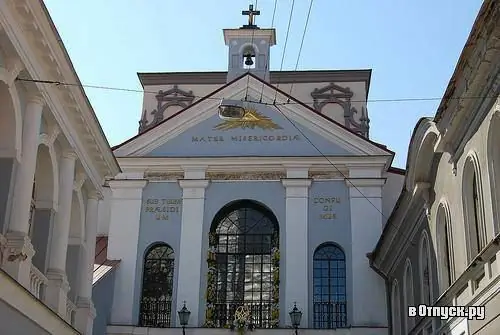
Description of the attraction
From the Lithuanian language, the name of the gate Aushros is translated as "gate of dawn". This gate is considered one of the most important landmarks and a symbol of the city of Vilnius. Aušros is the most famous shrine of the Catholic faith in all of Lithuania, as well as abroad. In addition, the gate was one of the five first gates in Vilnius, which were erected along with the well-known and recognizable city wall. In height, the gate is comparable to a three-storey building and is located in the south of the Old Town, and then connects to one of the longest and now preserved parts of the defensive wall.
The Ausrus Gate was previously called the Medical Gate and was built in 1522 at the intersection with one of the main trade routes, which originated in Vilnius, then passed through the village of Medininkai, then followed to Minsk, then to Smolensk and Moscow. Nowadays, through these gates, you can immediately get directly to the Old City.
In the chapel of the gate of Ausros there is an image of the great Merciful Mother, which is well known to all Catholics around the world. Later, the image of the Holy Virgin Mary was bordered in a gold frame, but the master who performed this work in the 17th century remains unknown.
The gate is the most typical Renaissance building. The main facade of the gate is decorated with beautiful griffins, which guard the symbols of the state power of the Grand Duchy of Lithuania. Above the bell tower there is a frieze on which the inscription “Mater Misercordia” is engraved, which means “grieving mother”. A long time ago, right in front of the gate, there was a moat with water, and a drawbridge towered above it. The most beautiful view of the gate opens from the eastern side of the facade of Ausros, because it is here that you can see the longest side of the city wall.
As you know, the tradition of creating a chapel located above the city gates can be seen and observed in a large number of cultures. The chapels contain icons that were supposed to protect and protect the city from invading enemies, as well as bless all those who enter or leave the city.
Not far from the gate is the Church of St. Teresa, whose Carmelite monks built a chapel in the upper part of Ausros in 1671. It was in it that the miraculous icon of the Mother of God, so highly respected by all believers, made by the hands of an unknown artist at the beginning of the 17th century, found shelter.
You can often find the second name of the icon - the Vilnius Madonna. This name is known to all Catholics around the world, because copies of this icon are in many churches around the world, including the Church of St. Severin in Paris and the Basilica of St. Peter. The icon depicts the Virgin Mary without a baby. Particularly surprising is the fact that the icon perfectly combines all the traditions of icon painting, as well as features of the Gothic style. Later this icon was gilded, although the date of this event is still unknown.
For a long time, the gate of Ausros has always been a popular pilgrimage site for all Catholics. Even today, the chapel always gathers a huge number of people who are so eager to see the miraculous icon, as well as to be cured of various and all kinds of diseases. During the visit of John Paul II to Lithuania, in September 1993, from the windows of this chapel, he addressed all the faithful.
In addition, the feast of the Mother of God is considered not only one of the most important and revered, but also the most beautiful and memorable religious holidays celebrated in Vilnius on the third week of November.






